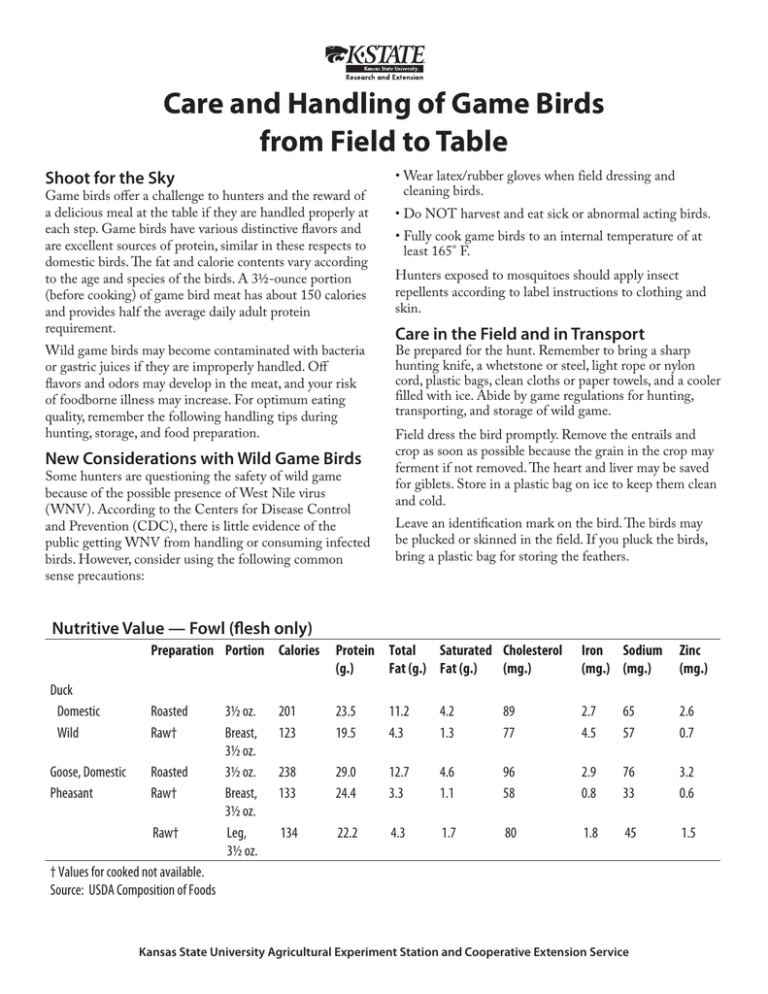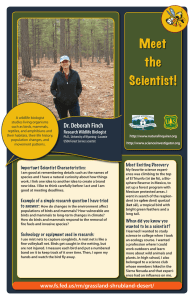
Care and Handling of Game Birds
from Field to Table
Shoot for the Sky
Game birds offer a challenge to hunters and the reward of
a delicious meal at the table if they are handled properly at
each step. Game birds have various distinctive flavors and
are excellent sources of protein, similar in these respects to
domestic birds. The fat and calorie contents vary according
to the age and species of the birds. A 31/2-ounce portion
(before cooking) of game bird meat has about 150 calories
and provides half the average daily adult protein
requirement.
Wild game birds may become contaminated with bacteria
or gastric juices if they are improperly handled. Off
flavors and odors may develop in the meat, and your risk
of foodborne illness may increase. For optimum eating
quality, remember the following handling tips during
hunting, storage, and food preparation.
New Considerations with Wild Game Birds
Some hunters are questioning the safety of wild game
because of the possible presence of West Nile virus
(WNV). According to the Centers for Disease Control
and Prevention (CDC), there is little evidence of the
public getting WNV from handling or consuming infected
birds. However, consider using the following common
sense precautions:
• Wear latex/rubber gloves when field dressing and
cleaning birds.
• Do NOT harvest and eat sick or abnormal acting birds.
• Fully cook game birds to an internal temperature of at
least 165° F.
Hunters exposed to mosquitoes should apply insect
repellents according to label instructions to clothing and
skin.
Care in the Field and in Transport
Be prepared for the hunt. Remember to bring a sharp
hunting knife, a whetstone or steel, light rope or nylon
cord, plastic bags, clean cloths or paper towels, and a cooler
filled with ice. Abide by game regulations for hunting,
transporting, and storage of wild game.
Field dress the bird promptly. Remove the entrails and
crop as soon as possible because the grain in the crop may
ferment if not removed. The heart and liver may be saved
for giblets. Store in a plastic bag on ice to keep them clean
and cold.
Leave an identification mark on the bird. The birds may
be plucked or skinned in the field. If you pluck the birds,
bring a plastic bag for storing the feathers.
Nutritive Value — Fowl (flesh only)
Preparation Portion Calories
Protein Total
Saturated Cholesterol
(g.)
Fat (g.) Fat (g.)
(mg.)
Iron Sodium
(mg.) (mg.)
Zinc
(mg.)
Duck
Domestic
Wild
Roasted
Raw†
201
123
23.5
19.5
11.2
4.3
4.2
1.3
89
77
2.7
4.5
65
57
2.6
0.7
Goose, Domestic
Pheasant
Roasted
Raw†
238
133
29.0
24.4
12.7
3.3
4.6
1.1
96
58
2.9
0.8
76
33
3.2
0.6
134
22.2
4.3
1.7
80
1.8
45
1.5
Raw†
31/2 oz.
Breast,
31/2 oz.
31/2 oz.
Breast,
31/2 oz.
Leg,
31/2 oz.
† Values for cooked not available.
Source: USDA Composition of Foods
Kansas State University Agricultural Experiment Station and Cooperative Extension Service
Cool the carcass quickly to retain flavor and maintain
the quality of the bird. A temperature above 40° F is
meat’s worst enemy. Wipe out the cavity with a clean
cloth or paper towel. Do not use grass or snow as this
may contaminate the carcass. Allow air to circulate in the
carcass by hanging or laying the bird in a well-ventilated
place. In hot weather, place the birds individually in plastic
bags and put on ice. Do not pile warm birds in a mass.
Store the birds in a cooler or ice chest out of the sun.
Keep birds cool during transport. The best way to store
them is in a cooler on ice. If this is not possible, keep the
car well-ventilated and put the birds on the back seat or
floor. Do not transport them in the trunk because the
enclosed space does not allow heat to escape from the
birds.
Care in Processing and Storage
Don’t cross-contaminate during processing. Wash your
hands, knife, and cutting board with hot soapy water and
rinse thoroughly.
When preparing ducks, remove the wings by cutting
them off at the joints, remove the head, and pluck the pin
feathers. Feathers may be removed by scalding the birds in
hot water (145° F). Pin feathers and down may be removed
by dipping the feathered bird in a paraffin wax/hot water
mixture. After the wax hardens, the feathers may be
scraped off. When preparing upland birds, such as grouse,
pheasant, quail, and partridge, skin the bird and soak in
cold water for one to two hours to remove the excess blood.
Birds generally do not require aging. If you wish to age the
birds, holding them at just above freezing temperatures for
two to three days may increase the tenderness of the meat.
For immediate use, birds should be stored in the
refrigerator at 40° F or less and used within three days. For
long-term storage, the whole cleaned carcass or individual
parts may be frozen at 0° F or lower. Freeze the meat while
it is fresh and in top condition.
The advantage of packaging parts instead of the whole bird
is that bloody spots can be eliminated by cutting out or
rinsing out with cold water. Parts also fit conveniently in
your freezer. Parts may be boned, and the carcass and neck
my be used as a soup base. Use moisture/vapor-proof wrap
such as heavily waxed freezer wrap, laminated freezer wrap,
heavy duty aluminum foil, or freezer-weight polyethylene
bags. Wrap tightly, pressing out as much air as possible.
Label the packages with the content and date. Use the
frozen packages within a year.
Care in Preparation
Thaw the birds in the refrigerator or microwave. Food
thawed in the microwave should be cooked immediately.
Other thawed meat should be used within one to two days.
Keep raw food and cooked food separate.
The age of the bird determines the cooking method. Wild
game always should be cooked thoroughly to an internal
temperature of 165° F. At this temperature the juices run
clear and no pinkness remains in the meat. Young birds
have lighter legs, soft breastbones, and flexible beaks. Old
birds have darker, hard skinned legs, brittle breastbones,
and inflexible beaks.
Game birds may be prepared like chicken. Dry cookery
methods, such as frying, are appropriate for young birds.
Moist cookery methods, such as stewing or braising, are
appropriate for older birds. To decrease the distinctive taste
of some wild game, trim off as much of the fat as possible.
Older or skinned birds may become dry during baking.
You may want to wrap the birds with bacon to prevent
them from drying out.
Remove stuffing from the bird before storing, because
stuffing is a good growth medium for microorganisms. Use
leftovers within one or two days, or freeze for later use.
Revised by Karen Blakeslee, M.S., Extension Associate, Food Science
Adapted from From Field to Table: A Pocket Guide to Care and Handling of Game Birds by Julie Garden-Robinson, Food and Nutrition Specialist, North Dakota State University Extension Service, and Martin Marchello,
Professor, Department of Animal and Range Sciences, North Dakota State University, October 2003. Revised with permission by Karen Blakeslee, Extension Associate, Food Science, Kansas State University, November 2010.
Brand names appearing in this publication are for product identification purposes only. No endorsement is intended, nor is criticism implied of similar products not mentioned.
Publications from Kansas State University are available on the World Wide Web at: www.ksre.ksu.edu
Publications are reviewed or revised annually by appropriate faculty to reflect current research and practice. Date shown is that of publication or last revision. Contents of this publication may be freely reproduced for
educational purposes. All other rights reserved. In each case, credit Karen Blakeslee, Care and Handling of Game Birds from Field to Table, Kansas State University, November 2010.
Kansas State University Agricultural Experiment Station and Cooperative Extension Service
MF-2177
November 2010
K-State Research and Extension is an equal opportunity provider and employer. Issued in furtherance of Cooperative Extension Work, Acts of May 8 and June 30, 1914, as
amended. Kansas State University, County Extension Councils, Extension Districts, and United States Department of Agriculture Cooperating, Gary Pierzynski, Interim Director.






